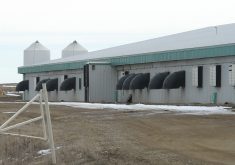The stars aligned for Bud Leis last year, helping him win the 2010 King of Canola Challenge.
The third generation producer from Togo, Sask., credited adequate moisture in a year that was generally too wet for most for his winning yield of 67.22 bushels per acre.
“We had borderline excessive rainfall this year,” he said.
“We were on the fringe of what was really excessive here. We weren’t drowned out, plus this canola was planted early. That’s important.”
Read Also

Phosphate prices to remain high
Phosphate prices are expected to remain elevated, according to Mosaic’s president.
The four-year-old contest, which is sponsored by Hudye Soil Services, allows producers to use any management strategy they see fit to obtain the highest canola yield possible, whether it be genetics, seed treatments, chemistries, fungicides or enhanced fertility and technologies.
Seven northeastern Saskatchewan producers accepted the challenge, planting their contest entries on predetermined 80 acre fields.
Contest winners receive a $5,000 travel voucher.
Leis chose one of the stronger pieces of flat, well-drained land on his 4,200 acre grain farm and began seeding May 13 using a wheat-canola rotation.
He seeded at 4.2 pounds per acre using a John Deere 1820 air hoe drill.
Agronomist Dan Owen of Hudye Soil Services created a fertility package based on the results of his soil analyses and Leis’ yield expectations.
Leis seeded Invigor 8440, which had a herbicide application of Liberty and Centurion. Included in this tank mix was the fungicide Tilt, Balancer, a micronutrient product containing boron and molybdenum, and Golden Harvest, a macro and micro nutrient product containing nitrogen, phosphorus, potassium and trace elements.
On July 1 he applied more Balancer and the fungicide Proline.
Owen said the amount of moisture Leis’ farm received forced him to tweak the fertility package.
“We obviously had excess moisture in the early part of the season, which did slow crop down,” he said.
“We used micronutrients to feed the plants through the leaves rather than the roots because obviously while the roots were in the water, they were restricted in their nutrient uptake. Basically we took the approach of feeding the plant through the leaves.”
Owen said they used the excess moisture to its full advantage.
“I think we enhanced what we did there. In a normal year when it’s a bit drier, the crop probably wouldn’t get to full maturity. Rather than maturing naturally, sometimes they tend to die off because of lack of moisture. We had the moisture to take the crop to full maturity.”
Owen also credited Leis’ timing when applying his fungicide, which helped keep the crop healthy.
A longer frost-free window was a bonus.
Leis swathed the crop Aug. 22.
“It was very wet when we were swathing, but we still managed to keep getting things done,” he said.
While rain fell on much of the Prairies as harvest began, the Togo area was reasonably dry and Leis started combining Sept. 26 using his John Deere 9860.
Owen judged one acre of combined swath from each entry, measuring the plot, swath and amount of dockage and moisture to determine the yield.
His calculations were then verified at Hudye Soil Services by Braden Hudye.
Owen said he is now working with growers who are preparing to enter this year’s competition.
“We take it quite seriously. Some guys will come in right from the start asking for soil test results; which fields look the best, which variety to grow, seeding dates, fertility packages, fungicide packages. It is taken as a whole crop management program right from the start.”
Leis wouldn’t reveal all of his secrets when it comes to producing award-winning yields.
“The serious farmers have their trade secrets,” he said. “There’s a certain amount of knowing your own land that is involved with this. Knowing what varieties of canola do seem to perform better on your land because there are differences. I know you can take a certain variety of canola that a company makes and it might perform better on your land then it would on somebody’s land 20 miles away. Those are things you can only learn from trying it and seeing for yourself.”
Owen has seen a competitive spirit among the growers who participate in the annual challenge and said he would like to see more growers compete because it helps maximize production.
“Increasing production will help drive down the unit cost of actually producing the crop,” he said.
This strategy comes with an increased management cost, which Owen said overwhelms smaller producers.
“It’s difficult to get some guys to compete because obviously there’s an enhanced amount of management with it,” he said. “We would have had a few more people in, but the weather at the end of it did tend to sort of knock a few of those out as well because the crops weren’t established as far as they could have been.”
Recipe for success
This was the fertility package Bud Leis used to produce his 2010 King of Canola crop:
•Nitrogen: 135 lb. per acre (120 lb. was anhydrous ammonia applied in the fall and rest was in a dry blend applied in spring)
•Phosphorus: 50 lb. per acre
•Potassium: 38 lb. per acre
•Sulfur: 25 lb. per acre















